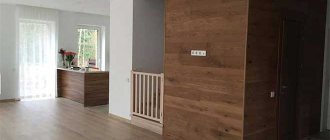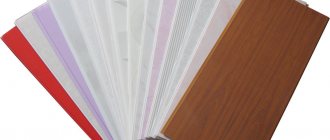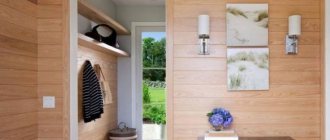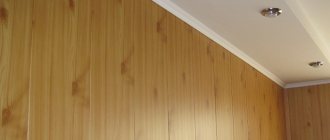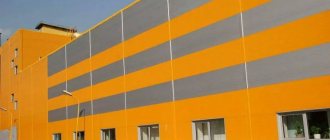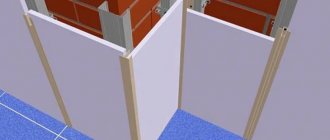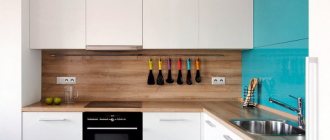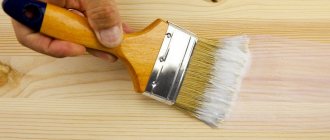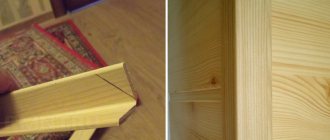The finely dispersed fraction, or more simply MDF, has long been widely popular in the construction market, and many have already appreciated its advantages, leaving ceramic tiles and plastic in the past. At its core, MDF (Medium Density Fiberboard) - where “Medium” means medium, is a board with medium density, for the manufacture of which fine wood shavings are used. But time does not stand still and progress takes its toll. More recently, the building materials market has been replenished with a new, improved material – HDF (High Density Fiberboard). It is also called HDF sheet, which is a higher density wood fiber board. What features does this type of finishing have and how does it differ from other materials, we will consider below.
A little more about HDF production
To produce HDF, waste left over from sawmills is used. If we talk about waste materials from woodworking enterprises, then only environmentally friendly materials, devoid of any harmful impurities, are used to produce such a board. This gives reason to compare this material with natural wood.
When manufacturing wall panels in HDF, wood can also be added after sanitary felling. The sawdust received by the enterprise is thoroughly crushed and then steamed. As a result, a sticky, binding substance called ligin is formed. Next, the fibers are dried with hot air and then pressed, forming panels of the required dimensions. This production process is also typical for MDF.
When the question is what is the best way to decorate an apron, of course, special attention is paid to such characteristics as the cost of the material, reliability and, of course, attractiveness. In this case, it is HDF that will serve as the “golden mean”, being more reliable than MDF and cheaper than tiles. An apron made of such material can compete with products made from natural wood. But, unlike wood, HDF is more resistant to temperature changes and exposure to a humid environment.
Instead of a tree
These new materials were developed as replacements for standard wood products such as plywood and natural wood veneers for flooring. Innovative material HDF - abbreviations, HDF, - High Density Fiberboard. It stands for high-density wood fiberboard, which is created using organic binders by pressing wood fibers under high temperatures and pressure.
The finished slabs have a dense, homogeneous structure, thanks to which the possibilities of their mechanical processing are much higher than that of natural solid wood. What is attractive about HDF boards? The fact that this is a natural coating, environmentally friendly, easy to process manually and mechanically, with significant noise absorption and excellent ability to retain heat, became known thanks to the testing of the material.
Technical characteristics of HDF
HDF boards are produced in two formats: 2800x2500mm and 2800x2070mm. If we talk about varnished ones, there is only one size - 2800x2070mm. Density indicators and thickness of the material are indicated in the next section.
HDF boards tolerate mechanical processing well and are easy to decorate and perforate. They can be drilled, sawn, bent, and also decorated with various decor without any problems. Due to this, it is possible to produce not only a durable, but also an original kitchen apron.
If you use varnish to cover the stove, it becomes more resistant to the negative effects of detergents, as well as various kitchen appliances. The laminated board is perfectly smooth and has a beautiful shine.
Manufacturing of fiberboard
Main components of fiberboard:
- wood;
Wood
- binders - polymer or mineral.
The slabs are formed after fluffing the wood to a fiber state. Such fine mechanical grinding is not possible without first cutting and softening the wood (with hot water or steam).
Fluffing is one of the ways of porousization of a material (that is, the inclusion of very small voids evenly distributed throughout the volume into its body). Relatively dense raw materials (sawdust, shavings, wood chips, slabs) after fluffing become fibrous material.
Forming of products begins with mixing a mass of wood fibers with water and additives (fire retardants, antiseptics, water repellents). The raw material suspended in water is poured onto the fine copper mesh of the casting machine.
After the water is filtered (this process is accelerated by a vacuum unit), a carpet of wet fiber remains on the mesh.
The next stage of board production is different for light fiberboard, MDF and HDF:
- to create a soft, low-strength, highly porous slab, the fiber is only dried (in a roller dryer);
- the result of compaction on a hot press (t = 150-165 °C, p = 1-5 MPa) is a fine-fiber material and, at the same time, hard and durable: medium and high density fiberboard.
The difference in density and physicochemical properties of solid slabs is achieved by changing the hot pressing time. Soft and semi-hard slabs are lightly pressed, and final drying occurs without compaction.
The same mass, completely dried under high pressure, becomes a solid finishing fiberboard. When making superhard slabs, the suspension is enriched with phenol-formaldehyde polymer (synthetic resin) before dehydration.
Characteristic differences between MDF and HDF boards
The increased density of HDF (from 800 to 1000 kg/m3) gives the product greater strength. Thanks to this indicator, even a thin board will be more reliable than a thick MDF sheet, the density of which is less than 800 kg/m3.
If we talk about the thickness of the material, then the typical indicator for MDF is 6 mm or more. HDF comes in sizes from 2mm to 6mm, but 3mm is most often used. These sheets are ideal for the production of aprons in small kitchen spaces, allowing you to significantly save space.
An equally important distinctive feature of the new material is its high environmental friendliness and safety, because the panel contains no harmful substances. In all respects, it is close to natural wood, differing only in a more reasonable cost. Based on the above, we can confidently note that kitchen aprons made of HDF will serve as an excellent replacement for the already familiar MDF panels.
MDF (Medium Density Fiberboard)
MDF (finely dispersed fraction) is widely popular among consumers in the construction market and has already replaced plastic and ceramic tiles in the back rows. Its benefits have been appreciated by many.
MDF is a board with medium density, the full name is Medium Density Fiberboard, where Medium means “average”. Fine wood shavings are used for its production. But technology does not stand still and develops, bringing new, more advanced materials and methods for their creation.
Not long ago, the building materials market was replenished with a new type - HDF. It is a fiberboard with a higher density. Let's look at how else it differs from other types of materials, and what features it has.
Advantages and disadvantages of panels
The main advantages of HDF include:
- homogeneity of the material, absence of voids and any compactions;
- harder surface and increased density;
- resistance to abrasion and aggressive substances;
- perfect size fit;
- ease of technical processing;
- good sound insulation;
- resistance to corrosion and fungi;
- excellent strength;
- ease of care;
- affordable price.
The disadvantages of HDF boards are insignificant. In damp and humid environments, the material is not endowed with sufficient moisture resistance. To solve this problem, it is enough to cover the panels with special profiles at the ends and at the joints using silicone glue.
MDF material is characterized by the following advantageous features:
- environmental friendliness, naturalness;
- ease of processing;
- good moisture resistance;
- hygiene, versatility;
- resistance to corrosion and fungi;
- safety at home;
- good heat and sound insulation;
- acceptable price.
The main disadvantage of MDF board is its low strength. Another drawback of this material is flammability. Therefore, in order to avoid short-circuiting the electrical wiring in the event of a fire, it is necessary to place the wiring under the panels only in a special corrugation.
HDF panels: difference, density and thickness of flooring material with finishing layer
Wood building materials are represented by lumber and wood composites. Composite wood products are divided into two large groups:
- laminated wood (from parts with undisturbed wood structure, veneer);
- materials based on wood, crushed to one degree or another.
The most famous representative of the second group is particle boards (chipboards). What is better for furniture, MDF or chipboard? Since the end of the 20th century, the popularity of products made from wood fibers - fiberboard - has been growing. These include MDF, HDF and LDF.
Also read about the differences between MDF and chipboard.
Wood-fiber materials are used in automobile, carriage, shipbuilding, furniture, carpentry and, of course, construction. In response to the growth of these industries, the production of panel materials is also increasing.
Application of HDF and MDF
HDF and MDF boards are used for almost the same purposes:
- imitation of natural wood by decorating and varnishing;
- production of rear furniture walls, interior doors;
- manufacturing durable inserts for both upholstered and cabinet furniture;
- as a base for laminate and parquet, for leveling walls;
- in order to hide ventilation holes and communications;
- in the field of carriage building, for exhibition and trade equipment;
- production of various stands, picture frames;
- for car interior trim.
HDF boards can also be used to make panels for the kitchen wall, which are called kitchen wall panels, imitating materials such as stone tiles or brick. HDF panels are ideal for the production of kitchen splashbacks and wall decoration.
Application in construction
HDF board is a versatile material that has natural bonding properties, resulting in excellent adhesion capabilities. The adhesive tightly grips the fibers without causing excess absorption. The result is a strong and reliable connection that perfectly replaces asphalt, bitumen and other roofing. These slabs are lighter than other materials and place less load on the roof.
HDF board - what kind of flooring is it? Flooring is the most popular application for this material due to its high density compared to wood flooring. The big pluses are the durability and sustainable properties of HDF compared to wood flooring or laminate.
Installation of a kitchen apron made of HDF panel, care features
If we talk about the method of fastening, then everything is extremely simple. HDF panels can be installed on an aluminum profile or a wooden frame. Liquid nails can serve as fastening to the wall. Installation is carried out in the same way as installing plastic or MDF panels.
It is important to note that you can use self-tapping screws or nails to attach a kitchen apron to the wall only if the surface is perfectly smooth and has been treated with a special antifungal solution.
To reliably install HDF panels, you must first build a frame, and only then fasten the board itself, using, for example, self-tapping screws.
Caring for a kitchen apron made of HDF does not require much effort. It is enough to wipe it with a damp cloth or cloth; use high-quality household products for cleaning. The panel is quite resistant to mechanical damage, so it is not “afraid” of various powder products or in the form of gel and cream. Using abrasive sponges may cause scratches.
With proper and careful care, kitchen aprons made of HDF can last for a long time without losing excellent performance characteristics.
Decorative use
So, HDF board - what is it: a decorative finish or a material for rough work? This material is also used for the manufacture of furniture decorative facades, as well as interior decoration in the form of wall panels and laminated floors. It is used to produce doors with trim, roofing materials, baseboards, decorative strips, profiles, and high-quality countertops. Furniture manufacturers have chosen these boards as a material for the production of drawers, partitions and upholstery of furniture backdrops due to their strength and resistance to moisture. Speaker manufacturers often use HDF to form the cabinet due to the versatility of the board as a whole and its excellent sound enhancing properties. HDF board will also help to realize various creative ideas. It has been known for a long time that this is a picturesque surface that is popular among artists. Creators work on it with acrylic and oil paints, but before using it they cover it with plaster or canvas.
HDF is one of the most important composite materials, which is often used instead of wood. Its properties are practically irreplaceable for decorating premises and performing artistic works.
Both materials are construction materials, they are wood panels, have a fairly high density, and are produced from waste remaining in sawmills. The materials are environmentally friendly, comparable to natural wood panels. To identify the differences between these two abbreviations, let us first consider their properties and technical characteristics.
Decorative finishing of fibreboards
Coatings protect the slabs from moisture and abrasion:
- enamel. The products become the most moisture-resistant, suitable for cladding the walls of grocery stores and medical institutions. Here about moisture-resistant MDF;
Enameled
- polymer films for rooms with high humidity in the bathroom and kitchen. Here about bathroom furniture;
Covered with polymer film
- paper impregnated with resins;
- paint - water-based polyvinyl acetate;
Painted
- plywood.
Plywood
Abrasion of the varnish film occurs to a greater extent on the inside of furniture made of MDF and HDF.
Microclimatic factors (mainly the difference in humidity that accompanies the change of seasons) affect wear and tear 3-4 times less than the use of the contents of cabinets and chests of drawers.
However, the coating on the back side of furniture is thinner than on the front side. Lamination of slabs with synthetic film is carried out on textured paper that imitates the cut of solid wood of a valuable species. This is how laminated wall panels are made.
Is the type of wood important in fiberboard?
The microstructure of coniferous and deciduous wood is different. Thus, only deciduous trees have tubes running along the trunk - vessels through which moisture rises from the roots to the crown. But in the trunks of coniferous trees there are intercellular spaces filled with resin (resin passages). The properties of specific breeds also vary.
The performance of most wood composites depends on the properties of the wood from which they are made. For example, the density of chipboard, poplar plywood is 450 kg/m3, birch is 650, and coniferous plywood is 550. Paulownia plywood is 1.7 times lighter than birch plywood.
The properties of products made from wood separated into fibers retain a connection with the species, but less significant. The macrostructure of the initial solid raw material has a weaker effect on the quality indicators of MDF and HDF.
It has been experimentally established that slabs made from coniferous tree fibers are the most durable. The reason for this is the peculiarities of the fractional composition of wood pulp and the shape of the particles. As for specific hardwoods, birch MDF and HDF are stronger than others, alder and aspen are “weaker”.
The inclusion of deciduous wood in the raw composition of a building material is fraught with a decrease in its physical and mechanical characteristics. Density and swelling are almost not affected, and the bending strength is reduced.
